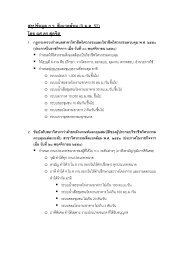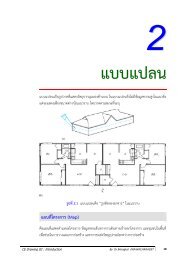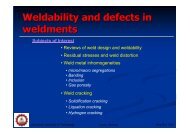Literature review - ???????????????????????????
Literature review - ???????????????????????????
Literature review - ???????????????????????????
You also want an ePaper? Increase the reach of your titles
YUMPU automatically turns print PDFs into web optimized ePapers that Google loves.
eaction occurred between the isocyanate group and carboxyl or hydroxyl end groups<br />
of PET. SEM micrographs of cryogenically fractured surface in HDPE-g-BHI/PET<br />
blends exhibited that HDPE-g-BHI/PET blends had a much finer dispersion of the<br />
dispersed phase than that of HDPE/PET due to the decrement of the interfacial tension<br />
between the continuous and dispersed phases. An in situ-formed graft copolymer<br />
reduced interfacial tension and increased interfacial adhesion between the two phases.<br />
The tensile strength and elongation at break of reactive compatibilized blends showed<br />
higher values than those of uncompatibilized blends. The result was confirmed by<br />
dynamic mechanical analysis. The HDPE-g-BHI/PET blends showed a greater storage<br />
modulus than that of the HDPE/PET blends at the same composition. This result could<br />
be interpreted as due to the formation of an in-situ graft copolymer. DSC results for<br />
HDPE/PET and HDPE-g-BHI/PET at the compositions 30/70 and 10/90 blends<br />
showed that at the same composition appeared to be little difference in the<br />
endothermic heat by PET melting and the exothermic heat by PET crystallization.<br />
These results showed that the crystallinity of the continuous PET phase in the<br />
HDPE/PET blends remained unchanged regardless of the reactive compatibilization of<br />
the blocked isocyanate group grafted onto HDPE.<br />
Lusinchi, Boutevin, Torres, and Robin (2001) studied in situ compatibilization<br />
of HDPE/PET (60/40) blends by interfacial grafting of maleic anhydride (MA)<br />
without initiator in the molten state. The grafting reaction of MA onto HDPE was<br />
carried out in a batch mixer varying reaction parameters of the temperature, roller<br />
speed, and time of reaction. In a first step, the reactive copolymer was prepared in situ<br />
by grafting MA onto HDPE. In a second step, succinic anhydride reacted with<br />
functional end groups of PET. The in situ grafting of MA onto HDPE led to the<br />
10
















